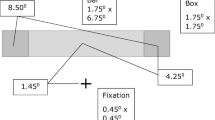Abstract
Tachistoscopic presentation of scenes has been valuable for studying the emerging properties of visual scene representations. The spatial aspects of this work have generally been focused on the conceptual locations (e.g., next to the refrigerator) and directional locations of objects in 2-D arrays and/or images. Less is known about how the perceived egocentric distance of objects develops. Here we describe a novel system for presenting brief glimpses of a real-world environment, followed by a mask. The system includes projectors with mechanical shutters for projecting the fixation and masking images, a set of LED floodlights for illuminating the environment, and computer-controlled electronics to set the timing and initiate the process. Because a real environment is used, most visual distance and depth cues can be manipulated using traditional methods. The system is inexpensive, robust, and its components are readily available in the marketplace. This article describes the system and the timing characteristics of each component. We verified the system’s ability to control exposure to time scales as low as a few milliseconds.




Similar content being viewed by others
Notes
It should be noted that the inclusion of a fixation point would lead the observer to fixate on a virtual location that depends on the distance from the beamsplitter to the projection screen. With or without a fixation point, the oculomotor posture of the eyes may not be informative about target distance when viewing time is limited. However, monocular and binocular forms of parallax—the cues that elicit accommodation and convergence—remain available and potentially useful sources of information about target distance (Foley, 1978).
Another consideration is that many solid-state relays designed for alternating current wait for a “zero crossing” to actuate, resulting in an unpredictable delay of up to 8 ms. This can be avoided by careful selection of the components.
Standard capacitors are (depending on their construction) generally only guaranteed to be within 10 % or 20 % of their nominal capacitance. Thus, a nominal 100-μF capacitor may range anywhere from 80 to 120 μF. The actual value must be determined though testing. However, the capacitance, once determined, is constant. The minimum nominal delay as the circuit is configured is theoretically 150 μs. To limit the current drawn by the delay circuit, an artificial lower limit of about 4 ms is enforced in software.
Because the photodiode saturates in the experimental configuration, we take the LED lamps to be fully illuminated when the photodiode output is at its saturation value. If we compare the rise and fall curves of the LED response in Figs. 2 and 3, it is clear that the LED has reached at least 75 % of full illumination at saturation.
References
Adam, J. J., Davelaar, E. J., van der Gouw, A., & Willems, P. (2008). Evidence for attentional processing in spatial localization. Psychological Research, 72, 433–442. doi:10.1007/s00426-007-0126-2
Becker, M. W., & Rasmussen, I. P. (2008). Guidance of attention to objects and locations by long-term memory of natural scenes. Journal of Experimental Psychology: Human Learning and Memory, 34, 1325–1338.
Breitmeyer, B. G. (1984). Visual masking: An integrative approach. New York, NY: Oxford University Press.
Breitmeyer, B. G., & Öğmen, H. (2000). Recent models and findings in visual backward masking: A comparison, review, and update. Perception & Psychophysics, 62, 1572–1595.
Breitmeyer, B. G., & Öğmen, H. (2006). Visual masking: Time slices through conscious and unconscious vision (2nd ed.). New York, NY: Oxford University Press.
Creem-Regehr, S. H., Willemsen, P., Gooch, A. A., & Thompson, W. B. (2005). The influence of restricted viewing conditions on egocentric distance perception: Implications for real and virtual indoor environments. Perception, 34, 191–204.
Eng, H. Y., Chen, D., & Jiang, Y. (2005). Visual working memory for simple and complex visual stimuli. Psychonomic Bulletin & Review, 12, 1127–1133.
Fischmeister, F. P., Leodolter, U., Windischberger, C., Kasess, C. H., Schöpf, V., & Bauer, H. (2010). Multiple serial picture presentation with millisecond resolution using a three-way LC-shutter-tachistoscope. Journal of Neuroscience Methods, 187, 235–242.
Foley, J. M. (1978). Primary distance perception. In R. Held, H. W. Leibowitz, & H.-L. Teuber (Eds.), Handbook of sensory physiology (Perception, Vol. VIII, pp. 181–213). Berlin, Germany: Springer.
Gajewski, D. A., Philbeck, J. W., Pothier, S., & Chichka, D. (2010). From the most fleeting of glimpses: On the time course for the extraction of distance information. Psychological Science, 21, 1446–1453. doi:10.1177/0956797610381508
Gajewski, D. A., Philbeck, J. W., Wirtz, P. W., & Chichka, D. (2014). Angular declination and the dynamic perception of egocentric distance. Journal of Experimental Psychology: Human Perception and Performance, 40(1):361–377. doi:10.1037/a0034394
Gegenfurtner, K. R., & Sperling, G. (1993). Information transfer in iconic memory experiments. Journal of Experimental Psychology: Human Perception and Performance, 19, 845–866. doi:10.1037/0096-1523.19.4.845
Greene, M. R., & Oliva, A. (2009). The briefest of glances: The time course of natural scene understanding. Psychological Science, 40, 464–472. doi:10.1111/j.1467-9280.2009.02316.x
Hollingworth, A. (2005). Memory for object position in natural scenes. Visual Cognition, 12, 1003–1016.
Huebner, G. M., & Gegenfurtner, K. R. (2010). Effects of viewing time, fixations, and viewing strategies on visual memory for briefly presented natural objects. Quarterly Journal of Experimental Psychology, 63, 1398–1413. doi:10.1080/17470210903398139
Irwin, D. E., & Yeomans, J. M. (1986). Sensory registration and informational persistence. Journal of Experimental Psychology: Human Perception and Performance, 12, 343–360. doi:10.1037/0096-1523.12.3.343
Irwin, D. E., & Zelinsky, G. J. (2002). Eye movements and scene perception: Memory for things observed. Perception & Psychophysics, 64, 882–895.
Loomis, J. M., da Silva, J. A., Fujita, N., & Fukusima, S. S. (1992). Visual space perception and visually directed action. Journal of Experimental Psychology: Human Perception and Performance, 18, 906–921. doi:10.1037/0096-1523.18.4.906
Microchip Technology Inc. (2003). Single/dual digital potentiometer with SPI interface (Microchip data sheet DS1195C). Chandler, AZ: Author.
Pothier, S., Philbeck, J., Chichka, D., & Gajewski, D. A. (2009). Tachistoscopic exposure and masking of real three-dimensional scenes. Behavior Research Methods, 41, 107–112. doi:10.3758/BRM.41.1.107
Rieser, J. J., Ashmead, D. H., Talor, C. R., & Younquist, G. A. (1990). Visual perception and the guidance of locomotion without vision to previously seen targets. Perception, 19, 675–689.
SHARP Corporation. (1999). Photodiode/phototransistor application circuit (Sharp Application Note SMA99017). Camas, WA: Author.
Sperdin, H. F., Repnow, M., Herzog, M. H., & Landis, T. (2013). An LCD tachistoscope with submillisecond precision. Behavior Research Methods, 45, 1347–1357. doi:10.3758/s13428-012-0311-0
Thomson, J. A. (1980). How do we use visual information to control locomotion? Trends in Neurosciences, 3, 247–250.
Thurgood, C., Patterson, J., Simpson, D., & Whitfield, T. W. A. (2010). Development of a light-emitting diode tachistoscope. Review of Scientific Instruments, 81, 035117.
Võ, M. L.–H., & Henderson, J. M. (2010). The time course of initial scene processing for eye movement guidance in natural scene search. Journal of Vision, 10(3):14, 1–13. doi:10.1167/10.3.14
Vogel, E. K., Woodman, G. F., & Luck, S. J. (2001). Storage of features, conjunctions, and objects in visual working memory. Journal of Experimental Psychology: Human Perception and Performance, 27, 92–114. doi:10.1037/0096-1523.27.1.92
Vogel, E. K., Woodman, G. F., & Luck, S. J. (2006). The time course of consolidation in visual working memory. Journal of Experimental Psychology: Human Perception and Performance, 32, 1436–1451. doi:10.1037/0096-1523.32.6.1436
Wu, B., Ooi, T. L., & He, Z. J. (2004). Perceiving distance accurately by a directional process of integrating ground information. Nature, 428, 73–77. doi:10.1038/nature02350
Author Note
This research was supported by NIH Grant No. R01EY021771 to J.W.P.
Author information
Authors and Affiliations
Corresponding author
Rights and permissions
About this article
Cite this article
Chichka, D., Philbeck, J.W. & Gajewski, D.A. Tachistoscopic illumination and masking of real scenes. Behav Res 47, 45–52 (2015). https://doi.org/10.3758/s13428-014-0449-z
Published:
Issue Date:
DOI: https://doi.org/10.3758/s13428-014-0449-z




